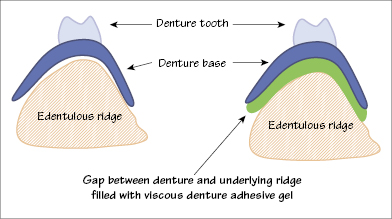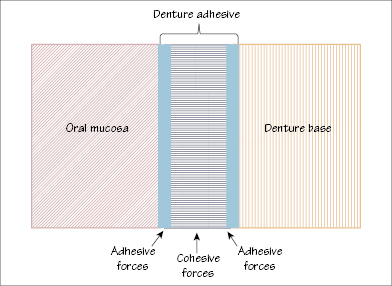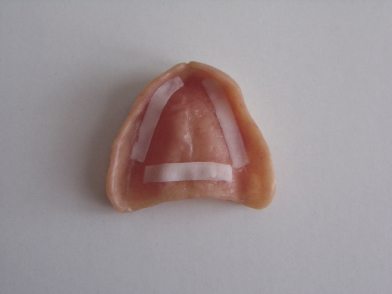30
Denture adhesives
Figure 30.1 Schematic representation of hydration of a denture adhesive to form a gel that swells and fills voids between the CD and its supporting tissues.

Figure 30.2 Cohesive and adhesive forces in a denture adhesive between a CD base and its supporting structures.

Figure 30.3 Gel denture adhesive applied to the intaglio surface of a lower complete denture.

Figure 30.4 Adhesive strips applied to intaglio surface of a complete upper denture.

Denture adhesives or fixatives are not luting agents per se, but these retention aids can be important in complete denture (CD) therapy by contributing to the “fit,” comfort, stability, and retention of dentures.
Clinically, the space between CD and tissue is filled with saliva, and retention directly relates to the salivary film properties (notably its viscosity and surface tension), the contact area between denture and mucosa, and the wettability of the intaglio surface. Patients with well-fitting dentures and good salivary flow generally experience few problems with stability and retention. Dry mouth (xerostomic) patients or those with poorly fitting dentures often resort to denture adhesives to enhance retention, stability, and performance.
30.1 Denture adhesives
Denture adhesives are nontoxic, soluble materials applied as a powder, cream, or pad to the intaglio surface. After application and seating of the denture in the mouth, the adhesive hydrates in the oral fluids to form a gel that swells, filling voids between the CD and its supporting tissues (Figure 30.1). These gels, more cohesive than saliva, adhere to both the intaglio surface and mucosa, functioning as bioadhesives and enhancing existing retentive mechanisms. In particular, they optimize interfacial forces and better resist dislodging forces than saliva by increasing the cohesion and viscosity of the fluid layer between denture and basal seat (Figure 30.2).
Stay updated, free dental videos. Join our Telegram channel

VIDEdental - Online dental courses


